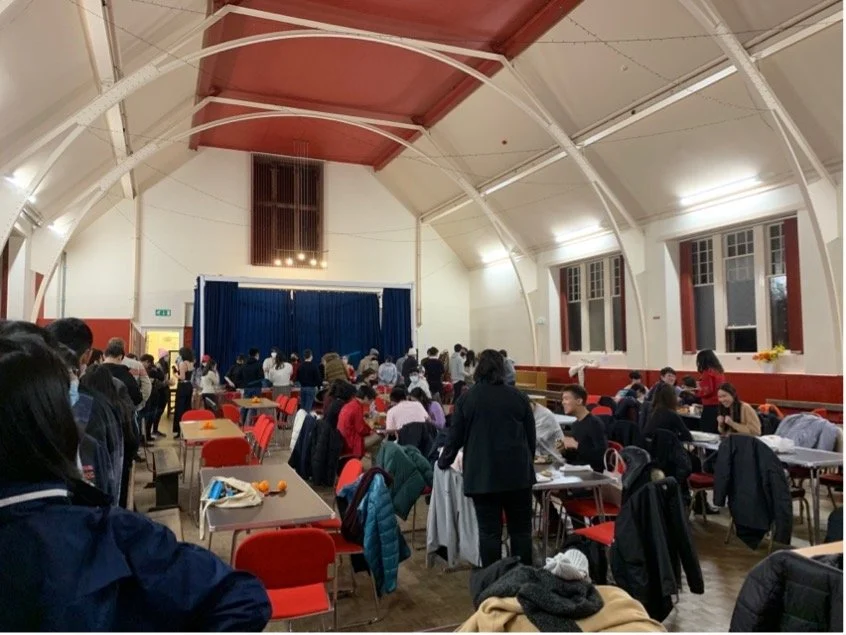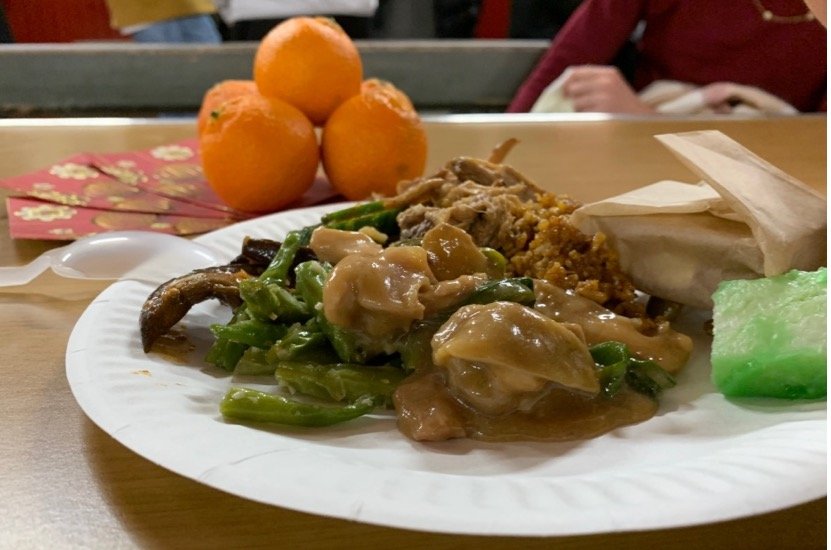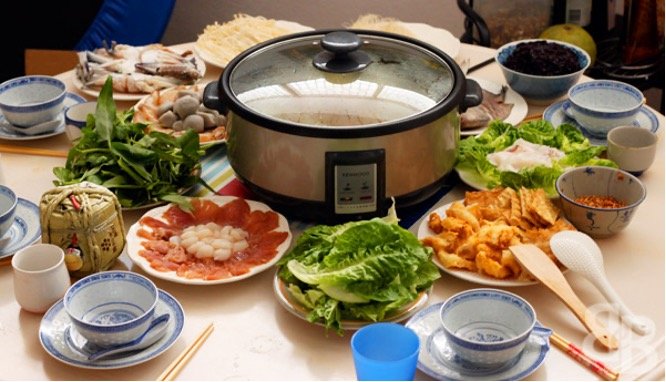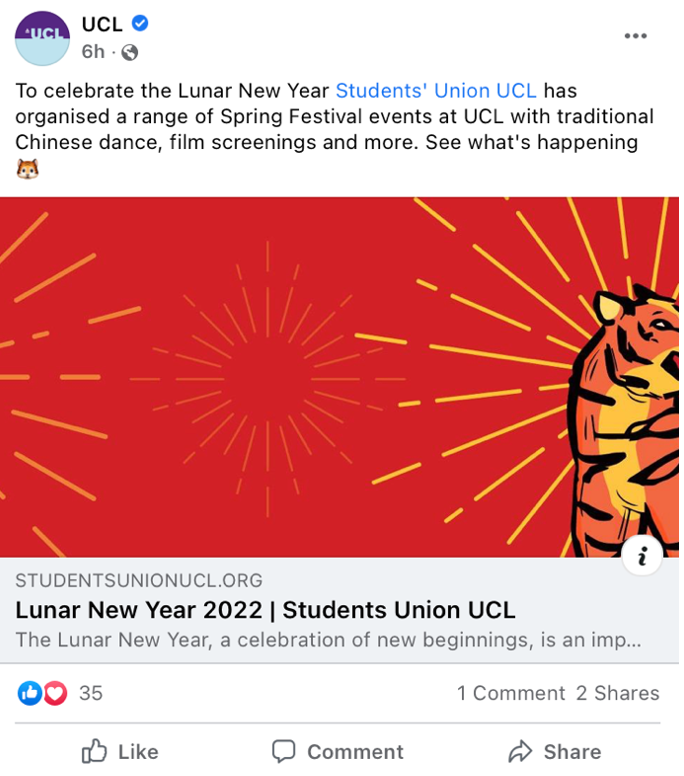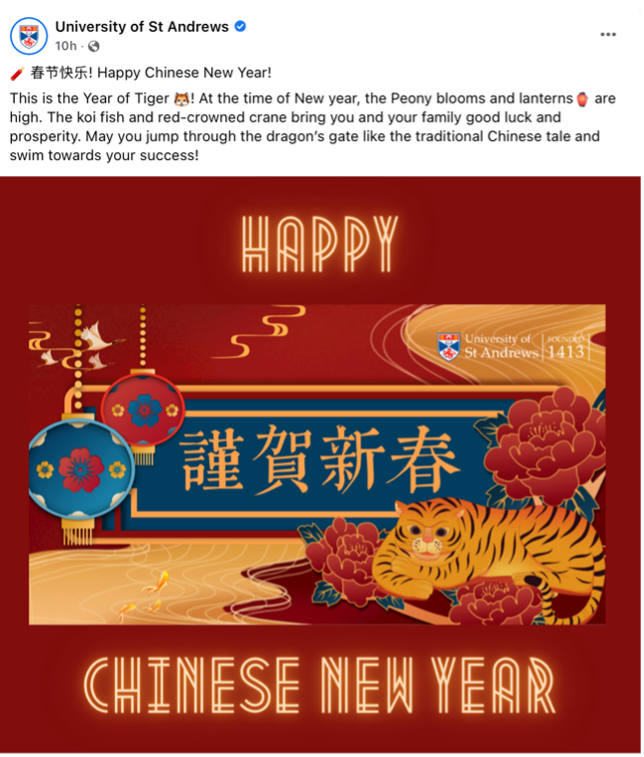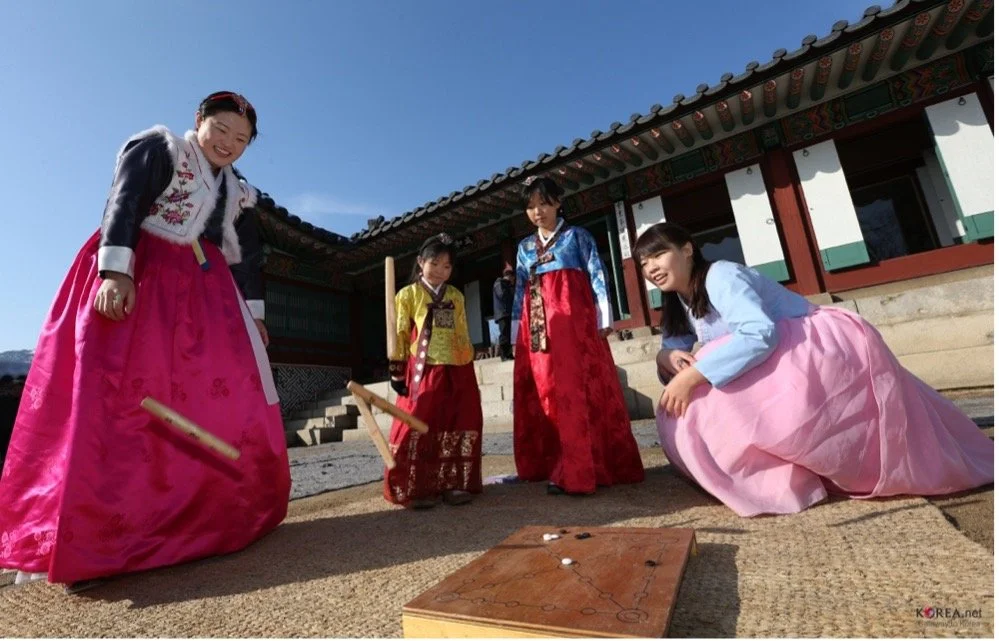On Lunar New Year in St Andrews
By Long Tran
Back home…we call Lunar New Year by the mononym Tết. Out of the innumerable soundtracks to the occasion, one song has always lingered. Ngày Tết Quê Em or ‘New Year in my hometown’ is essential and inescapable when the holiday comes, capturing the aura of this mononymic name:
Tết, tết, tết, tết, đến rồi / Tết đến trong tim mọi người
Tet, tet, tet, tet has arrived / Tet has arrived in everybody’s hearts
Meal eaten at Tết
My heart was stirred a few times by the atmosphere of true Viet New Year as a child: our house full of cousins and relatives; car rides to visit family friends; raucous drinking parties; a giant dish of fruits carefully arranged; bánh trưng, and xôi gấc – a kind of red sticky rice that I have loved since I was little, a fact that my grandmother reminded me of when I called her this year.
My first memory of the celebrations must have been when I was in kindergarten. We had a grand, sumptuous Lunar New Year’s Eve Banquet (年夜飯). Then, we went downstairs to our neighbourhood and set off fireworks and firecrackers to drive away evil and embrace the brand-new year.
Haomin, 4th year from Shanghai
Since I moved to Japan at twelve, the festival started to lose its glow. Since the nineteenth century, Japan had abandoned the lunisolar calendar system to which Tết belongs. The society of my new home forged past the occasion whereas relatives in the motherland enjoyed at least a week of vacation. A smattering of people at the international school noted the day of ‘Chinese New Year’. I scrolled through news and social media reporting on festivities happening in Yokohama Chinatown. Though the stir in my heart is but fading phantasia, I still dutifully spend time with my immediate family, sometimes at potluck gatherings with other Viet families in Japan. However, since I left for university, even that option is unviable.
Being here…my experience is by no means unique to the celebrants of Lunar New Year in St Andrews. Not being home when February often brings the new Lunar Year, means trying without guaranteed success to conjure that atmosphere with the limited tools available in this country. Some students post or comment on festive images familiar greetings like ‘新年快樂’, or ‘Happy Lunar New Year’. We facetime home like good Asian children and catch a glimpse of familial celebrations taking place there and not so much here.
What takes place here seem to be the dinners, often with close friends and flatmates.
In Korea the most important aspect of Lunar New Year (Seollal) is spending time with family and eating good food. In St Andrews, I had the opportunity to spend it with my second ‘family’ and ate great food. This year we had hotpot and made dumplings together. So, my Lunar New Year away from home were not too different besides the food we ate.
Alissa, 3rd year from South Korea
In 2020 just before the pandemic, I went down to London and celebrate the New Year there. That was the first time I spent it knowing well that I wouldn’t see my relatives at all, because any other year, I would have come back. It was a lot more memorable because the people whom I celebrated with, I spent five and a half years of life with them in boarding school. I call them as well during Lunar New Year – it’s an international support now…So many of them are still back home or in another country. But everybody got together on a call, and everybody came together in February just to celebrate it as a group. As a third culture kid in that sense that I moved around so much, it was equally important knowing that was another side of what family is…Celebrating with them, for all of us, was the first time we didn’t celebrate with family.
Caleb, 1st year from Singapore
One part of my Lunar New Year this year was eating with friends and three societies’ worth of people under the fluorescent light of Holy Trinity Church Hall. The event was delivered by the partnership between the St Andrews Malaysian International Group, Singaporean Society, and Hong Kong Society. Decorations were sparse beside the red packets and five tangerines placed on every table. Groups of students stood at their flagged stalls and gave out home-cooked meal portions to a hungry, mostly Asian crowd.
People lining up for food in Holy Trinity Church Hall – taken by the author.
Why…do we make the effort? To cook and set the tables, to spend money and trek over in the cold evening amidst our busy academic schedule?
For Caleb, it is partly about identity. Celebrating 新年 means keeping in touch with the Chinese part of himself – the heritage of his mother’s side – in a cosmopolis like Singapore. Caleb’s god-grandmother, who remembers her childhood and subsequent emigration from mainland China to Malaysia, is determined to preserve their identity and heritage by adhering to the old calendar and enacting traditional practices. Large-scale Chinese emigration to Malaysian peninsula dates back from the nineteenth century, perhaps explaining the decision to title the aforementioned event as ‘Chinese New Year’.
新年 simply means new year, un-modified without reference to ethnicity or the moon. In English, ‘Chinese New Year’ comes easily to Caleb as a direct translation from Mandarin and/or other Chinese languages. The adjective ‘Chinese' captures a meaningful facet of the festival as an occasion for some to claim their cultural heritage. The whole phrase also makes sense, perhaps to a lesser extent, for those who for most of their life participated in Chinese celebrations. In places like Singapore, those not of Chinese ethnicity still take part albeit without normal customs or words of greeting. The joy is carried over across seas and continents, and shared. The festival’s significance lies also in its capacity to gather families and friends and light (old) relationships anew.
The friend I went to the dinner with I have not seen in a while. We ate and talked as the evening descended onto a pub table. Old jokes were rehearsed with new acquaintances. New ones catalysed with old friends.
Food on New Year 2022 in St Andrews – taken by the author.
Yet, there was an uncanniness in the back of my mind about the celebration. The New Year for me is not Chinese the way people from these organising societies may conceptualise it. Tết is different from 新年 and both are different from 설날 (Seollal – the Korean celebration) in terms of food, language and meaning in the contexts of history. As neighbours, we have borrowed China’s three thousand years old lunisolar calendar system as technology and localised it to their circumstances, from the fourteenth century in Viet Nam and even earlier in Korea. These adopted calendars account for the altered moon’s shape seen from local geography, and for positions on the meridian lines (i.e., time differences). These three events often fall on the same date, but not always, not in 1985 when Tết came a day later.
Like the calendars, our traditions may have similar cores, but their flavours and flairs are consciously distinct. We all feast, clean, and pray. We reunite with family, gift children money and pay respect to our elders. Even when I am in St Andrews, Tết is incomplete without calling my relatives. Haomin concurs and I suspect this is true for most celebrants out there. Yet for the rhythms of greetings in our languages and tastes of the yield of our lands, this occasion can be a potent reminder of our historical belongings.
Steamboat – popular meal eaten at 新年.
Representation…matters. The name people use for the occasion in English matters to me. Diasporic movements entail translation to a new common language – an act as eye-opening as it is problematic. Tết and 설날 are not Chinese; they, among others, are at the very least Lunar.
Something seems wrong when Western media (like the BBC) or social media (like our University of St Andrews’s Facebook account) use ‘Chinese New Year’ to speak of the celebrations occurring on this occasion. The phrase smells of racial microaggression on their pages. Ignorance and invalidation of interethnic differences in particular is an experience I am sure most Asians in this town share. The category includes comments like ‘all Asians look the same’ or the assumption of Chinese or Japanese identity on every East Asian person.
What does it mean for our university to post about ‘Chinese New Year’ (consistently, since 2015)? Either it believes only the Chinese tradition is worth celebrating or this global institution is insensitive to the distinctiveness of other traditions.
In comparison, ‘Lunar New Year’ as adopted by most other so-called elite universities in the United Kingdom (and most news media in the United States and Canada), is much preferred. These strange words are not the literal translations from any language. ‘Lunar’ is not even accurate for a calendar system that also observes solar events. Yet to eyes and ears weary from and wary of racism, they become a recognition of diversity, of openness and preliminary acceptance of difference in a multicultural context like St Andrews or perhaps the United Kingdom.
University of St Andrews and UCL celebratory posts on February 1st, 2022.
Where ‘Chinese New Year’ had been rolling off tongues for centuries, the uncanniness of ‘Lunar New Year’ unsettles stereotypes and racialist intuitions to clear a space for understanding how cultures merge and diverge in symbols and meanings.
The problem is not just in words. Imagery stands beside language as means of representation. For example, though red dominates as the colour of Tết and 新年 you find alongside it a variety of bright colours like pink or blue, symbolising a future just as glowing. For another example, the lunisolar calendar assigns each year a zodiac animal in a cycle of twelve. This much is common knowledge. 2022 is the Year of the Tiger and of course, the tiger proliferates in advertisements, social media captions, and postcards. However, next year will be that of the Cat for the Vietnamese and of the Rabbit for the Chinese. What choice will those who proclaim themselves to stand for diversity and inclusion, make?
Traditional clothes at 설날.
St Andrews…despite its overwhelming whiteness, is a place you encounter people from all different parts of the world, as a product of global migration processes. The resulting cosmopolitan sensibility encourages encounters of cultural practices, to wonderful results, especially in the context of successive Covid restrictions. One of my best memories here was made during (American) Thanksgiving last year when all my friends were able to gather in one place after our two rough years. We had turkey and stuffing, watched American football (which I did not understand one bit). Amongst the dozen present then, only three were Americans. Yet, the atmosphere was warm, the food was delicious, and I gave my thanks as if I share in the origin of that cultural act.
As people who are far away from home and/or part of the diaspora, we take comfort in our traditions and protect them from slight and invalidation by others. These festivals after all keep our identity intact. Yet, sometimes, what is truly important about these festivals is lost in the yearly repetition back home and found in the almost blank canvas of a foreign land. We find ourselves to be St Andreans here – American St Andreans, British St Andreans, Chinese St Andreans, Vietnamese St Andreans, etc. And to be all those flavours of St Andreans, is to share your cultural celebrations, as best as you can, with others from every part of the world. In return, only curiosity and a decency towards difference are asked for.
ST.ART does not own the rights to any images used in this article.


